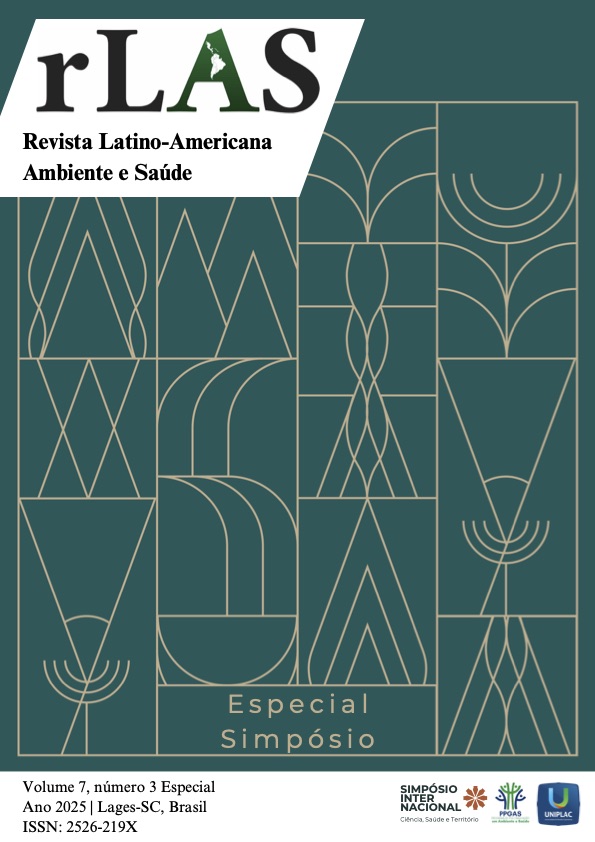Allelopathy effect of Lantana camara extract on germination and initial development of ryegrass
Keywords:
allelochemicals, secondary metabolites, weedsAbstract
The species Lantana camara is a weed with significant allelopathic potential, due to its high capacity to produce secondary metabolites in its leaves. The objective of this study was to evaluate the allelopathic effect of the aqueous extract of L. camara leaves on the germination and initial development of Lolium multiflorum. The stock extract was prepared from a solution consisting of 10 g of dried, ground L. camara leaves to 100 mL of water. The mixture was kept at a temperature of 25ºC for 24 hours. After this period, the supernatant was recovered, obtaining a 10% (w/v) extract, which was then diluted to concentrations of 0, 5, 10, and 20% and subsequently used in the assays. The percentage of normal seedlings, shoot length (SL), root length (RL), total length (TL), and dry mass (DM) were evaluated. The application of the aqueous extract of L. camara caused a reduction in the germination of ryegrass seeds at concentrations of 10 and 20%. Analyzing the allelopathic potential of Lantana camara on SL, RL, TL, and DM reveals a linear decreasing trend in these variables. The plant L. camara contains allelochemicals that, upon contact with other plants, have the ability to retard growth by interfering with metabolic activity. The concentrations evaluated in this research caused a reduction in seedling length and dry mass, decreasing the chances of seedling survival and impairing the initial establishment of Lolium multiflorum seedlings.
References
CARVALHO, S.; I.; C. Caracterização dos efeitos alelopáticos de Brachiaria brizantha cv. Marandu no estabelecimento das plantas de Stylos anthesguianen sisvar. Vulgaris cv. Bandeirante. 1993. Dissertação (Mestrado em Zootecnia) - Universidade Federal de Viçosa, Viçosa-MG, 1993.
CHENG, F; CHENG, Z. Research progress on the use of plant allelopathy in agriculture and the physiological and ecological mechanisms of allelopathy. Frontiers in Plant Science, v. 6, p. 1-16, 2015.
GINDRI, D. M; COELHO, C. M. M; UARROTA, V. G. Efeitos fisiológicos e bioquímicos de aleloquímicos de Lantana camara L. na germinação de sementes de Avena sativa. Pesquisa Agropecuária Tropical, v. 50, p. 1-11, 2020.
IQBAL, A. et al. Plants are the possible source of allelochemicals that can be useful in promoting sustainable agriculture. Fresenius Environmental Bulletin, v. 28, p. 1040-1049, 2019.
KATO-NOGUCHI, H.; KURNIADIE, D. Allelopathy of Lantana camara as an invasive plant. Plants, v. 10, n. 5, p. 1028, 2021.
MISHRA, A. Allelopathic properties of Lantana camara. International Research Journal of Basic and Clinical Studies, v. 3, n.1, p. 13-28, 2015.
NAKAGAWA, J. Testes de vigor baseados no desempenho das plântulas. In: KRZYZANOWSKI, FRANCISCO; VIEIRA, ROBERVAL; FRANÇA-NETO, JOSE. (Ed.). Vigor de sementes: conceitos e testes. Londrina: ABRATES, 1999.
R CORE TEAM. R: A language and environment for statistical computing. R Foundation for Statistical Computing, Vienna, Austria, 2021.
REZENDE, C.; P. et al. Alelopatia e suas interações na formação e manejo de pastagens. Boletim Agropecuário, v. 1, n. 54, p. 1-55, 2003.
RUSDY, M.; AKO, A. Allelopathic effect of Lantana camara and Chromolaena odorata on germination and seedling growth of Centroma pubescens. International Journal of Applied Environmental Sciences, v. 12, n. 10, p. 1769-1776, 2017.
VIDAL, R. A. Interação negativa entre plantas: Inicialismo, Alelopatia e Competição. Porto Alegre: Evangraf, 2010.
ZHANG, Z.; LIU, Y.; YUAN, L.; WEBER, E.; VAN KLEUNEN, M. Effect of allelopathy on plant performance: a meta‐analysis. Ecology Letters, v. 24, n. 2, p. 348-362, 2021.


